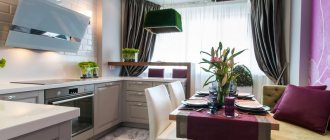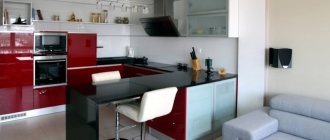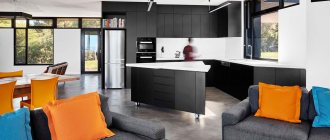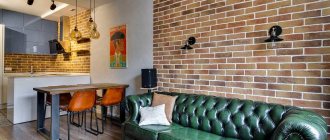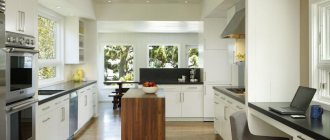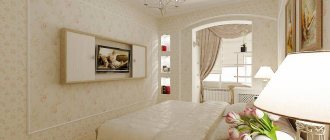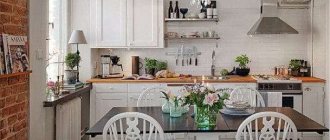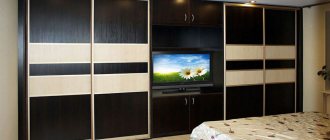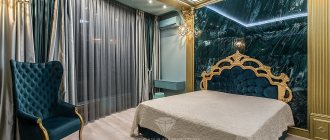Having a separate room for meals is a luxury that is unaffordable for many. So you have to work with all your might to turn your tiny kitchen into something more comfortable and attractive for the household, start remodeling and develop the design of the living room dining room, which will very soon appear in the house.
living room dining room design in light colors
Uniting space
A room with this layout is a combination of dining and guest areas. A kitchen is often adjacent to it, but its space, in this situation, is perceived as a secondary component of the overall decor. The key point in designing a single living room dining room will be the creation of a truly harmonious space, which, in addition to general stylistic features, will have clear zoning.
the sofa acts as a functional separator between the living and dining areas
The dining-living room in the apartment can be organized in the room for receiving guests, in areas combined with the kitchen, or in a specially designated room in the house.
An atmosphere of peace, comfort, coziness should reign in it - only in this case the newly appeared room will become a favorite gathering place for all household members. To cope with this task, you will have to work hard on the design of the future living room dining room: fill the decor with non-trivial accessories, furnish it with original furniture, and also provide the space with the right lighting .
Photos of interiors in various styles
The interior in a modern style is distinguished by its laconicism, originality of finishing materials and combines innovative technologies with long-standing design traditions.
The classic style, with its refined gloss and expensive elegance, requires precise symmetry in the placement of decorative elements and furniture. The environment welcomes the presence of natural materials, ceramics and bulky lighting fixtures.
The loft style fits perfectly into the combined rooms. The design features brickwork, modern cladding and bold combinations of various elements.
The photo shows a combined kitchen-dining-living room in a modern style with an interior designed in white and green tones.
The Art Deco movement is characterized by particular beauty. For the interior, it is appropriate to use natural materials and glass structures in the form of lampshades or separate inserts. The design contains natural curves and plant motifs.
Scandinavian design features light bleached colors combined with natural wood, which is quite a fashionable duo at the moment.
Basic Design Principles
The following requirements are put forward for the dining room:
- Space. The room should be free to accommodate all family members and visiting guests.
- Functionality of space use.
- Organization of areas for relaxation and eating.
- Increased comfort, that is, taking into account all the wishes and needs of family members.
living room dining room design in classic style
It is imperative to fulfill these conditions, no matter how difficult it may be to implement them. The specific implementation of the above requirements will largely depend on the chosen design style of the dining room. Empire, classic, and vintage can be reproduced in this room, but do not forget that there will be a place for relaxation, so preference should be given to “calm” directions. Nothing should distract you from enjoying food and relaxation. Most often, the dining room and living room are styled in the classic version, including:
- Pastel light main background.
- The presence of arches.
- Expensive furniture made from natural materials.
- Mirrors.
the dining room wall, decorated with artificial stone, delimits the space in the room
The surface of the walls may look like natural untreated plaster. They can be laid out in mosaic fragments or decorated with majolica. The floors in the dining room can be covered with parquet, ceramic tiles, porcelain stoneware, stylized stone or wood, as well as laminate. The decor must certainly include artistic forging items. The furniture is made of natural wood and with expensive upholstery. Antique lamps and paintings are welcome.
Decorating a small dining room
For small rooms, the most laconic and unpretentious designs are usually chosen. Most often this is minimalism, modern technological trends, eco-style. They are also suitable for decorating country houses, combined spaces of small area, one-room apartments, when the room performs several functions simultaneously. In any case, multifunctional, transformable, minimalistic solutions become useful.
The design of a small dining room involves maximum merging of zones. Instead of a table, a bar counter or part of the kitchen unit can be used here, if the work unit is also included in the space. You can consider folding models: such dining groups for the dining room and living room can be a continuation of the window sill with a folding tabletop. You can use a convertible coffee table. Together with the sofa, you get a very cozy living room, which actually serves as a dining room.
There will be no capital partitions or other voluminous zoning instruments. A small dining-living room is most often divided into zones using only visual methods - arranging furniture, choosing an inconspicuous dining set. In a country house decorated in country or Provence style, you can use curtains arranged in beautiful cascades.
Proportional furniture is chosen for a small living room, and this becomes the key to harmony and comfort. They save space with the help of multifunctional storage spaces, arranging them in a variety of corners, under the ceiling and inside ordinary furniture.
Specific design of the dining room living room
“In the design of the living room dining room, you need to create not only a cozy place for family meals, but also make the atmosphere pleasant for receiving guests and general gatherings with friends.”
One of the canons of the dining and living room interior is the unity of color scheme. Only in this case will the room be able to amaze not with a cacophony of finishing materials, a collection of mismatched furniture and overloaded decor, but with the integrity of the space and the commonality of design concepts. This does not mean that more than a couple of colors cannot be used in the decor - developing the style of this specific room allows you to play with tones and introduce bright accents from textured materials into the overall background.
beamed ceiling in the interior of the living room combined with the dining room
High-quality lighting of the room is a great help in creating an interior. Multi-level ceilings should be equipped with spotlights or built-in lighting. Chandeliers can hang above the guest and dining areas. Don't forget to use natural light. The window area will be a great place to place a dining table.
In the design of the living room dining room, you need to create not only a cozy place for family meals, but also make the atmosphere pleasant for receiving guests and general gatherings with friends. That is, the atmosphere of this room should contain both a certain formality and lightness. And this must be achieved by all available means, because a room that carries a social load has become an urgent necessity for secular and sociable people.
a single color scheme in the interior design of the living room and dining room
Living-dining room interior style
The atmosphere in the house or apartment depends on the style in which the design of the living room and dining room will be decorated. It is important that the interior matches your lifestyle and worldview. For example, active modern people who rarely devote enough time to family rituals and dinner meetings are unlikely to appreciate the solemnity and elegance of a classic design that demonstrates eternal values.
- Today, the luxury category includes aristocratic trends: an elegant living room and dining room, the design of which is implemented in a classic style, always looks expensive, elegant, and luxurious . Openwork ornaments, carved details, a noble palette and natural materials - this design is formed by decorative, relief elements, slender forms and symmetry.
- Of course, a modern dining room and living room in a private home can also be elite - here luxury is expressed in other ways . These are exquisite unusual shapes, cosmic features, expensive materials, and an abundance of glass. Dining groups for the dining room and living room in such directions can be made in a completely unimaginable form - as far as the designer’s imagination is sufficient.
The photo shows the design of a dining room in a futuristic style.
- To arrange a living room combined with a dining room in a wooden house, you should pay attention to such trends as country, Provence, eco . Plank or log walls provide the optimal backdrop for these simple, natural, natural styles. They are dominated by clear forms, cozy materials and textiles, and a harmonious palette. The shape of furniture can follow the contours of natural objects, especially in eco style, where unusual shapes of ordinary objects are appropriate - for example, lamps and poufs in the form of cobblestones. In country and Provence, the forms are simple - they are straight, sometimes not even carefully hewn lines.
- The interior design of the dining room and living room in the Scandinavian style is a bright, spacious solution with a white background, natural wooden surfaces and gray textiles. Smoky acts as a shadow, emphasizing the bright natural light, as well as the absence of curtains.
- The choice of styles in a modern way provides the opportunity to choose not only ultra-technological and exclusive futuristic trends, but also multifunctional, but simple solutions . This is exactly what the design of a dining room in a private house in contemporary style will be like. This is a combination of a simple white background, natural wooden surfaces, and a couple of bright details. Modern classics - this is how the design names are interpreted, in which everything is clear, convenient and functional.
Of course, it is not the direction itself that creates harmony: decor, styles and colors, shapes, lines, surfaces - everything together participates in the composition.
How to decorate the interior
“In addition to the furniture required for such rooms, such as a sideboard, buffet, table, chairs, etc., the design of a living room dining room must certainly include a soft corner, a large-screen TV, and a stereo system.”
When combining a kitchen with a dining room, you should consider how to make the expanded space comfortable and multifunctional. And the first thing to do in this direction is to separate the dining area from the work area. An arched opening installed instead of doors will cope best with this task. It will add style to the interior and add light and spaciousness to the room.
The space in modern interiors is well zoned by multi-level ceilings, floors with height differences, connected by steps, and sliding doors of different shapes. The use of different textured and multi-colored materials in the design of the open spaces of the dining room and living room makes it possible to find successful combinations of room decoration and thus also divide the space into zones .
fireplace as a traditional attribute of a living room combined with a dining room
Since the kitchen is a room that requires regular cleaning, and wet cleaning at that, it is better to decorate it with tiles or washable wallpaper, but in the dining area you will need materials that create comfort and give the atmosphere coziness. Textile wallpaper, paintable wallpaper, as well as carpeted flooring will be great here.
Combining a dining and living area will be an incredibly practical option, because in this case it becomes possible to quickly move after dinner to a relaxation corner, so that you can continue communication there, in soft light and in comfortable armchairs. You can separate these areas of the room with light partitions, which become additional interior decoration, or furniture, which fills the entire space with comfort.
A wooden stand is used to divide the living room and dining room space
In addition to the furniture required for such rooms, such as a sideboard, buffet, table, chairs, etc., the design of a living room dining room must certainly include a soft corner, a large-screen TV, and a stereo system. These are the items that add comfort to the environment and promote relaxation.
It is difficult to overestimate the presence of a fireplace in the decor, especially when standing against the backdrop of Venetian plaster. Interiors from the Renaissance era and in the spirit of eclecticism are an excellent solution for rooms with such a multifunctional load.
separation of living and dining areas using lighting
Choosing colors for the living-dining room
In private houses with spacious rooms, the color of the living room and dining room itself can be anything, although most often it is determined by the style and character of the design. But it is worth considering that the purpose of these zones differs significantly, and a number of shades worsen or, on the contrary, increase appetite, allowing you to concentrate attention rather than relax. That is why the interior design of the living-dining room should take into account the functional features of the room.
- It is not recommended to choose too dark and gloomy tones - black, blue, deep green or gray. Red, burgundy, and scarlet would also be inappropriate.
- For decoration, you should still choose neutral shades , which will help decorate the space in a single style and harmonious palette. Bright accents will become the connecting elements: in the living room it can be a floor lamp, and in the dining room it can be lamps above the table. Bright curtains and chair upholstery in the same color will help harmoniously fit dining groups for the dining room and living room into different spaces.
- The interior of the living room and dining room can be connected by details - appliances, materials, textures, but in a different palette. These may be the same patterns, shapes, lines, but for the guest area they choose a more saturated color, and the dining area is decorated in more “appetizing” or neutral tones.
The leader in use is still white – it is universal in its application. Beige is considered softer, which can also easily be used in different styles and directions. These ranges are complemented by rich brown – the color of wood, dark gray – a shade of concrete and metal, as well as eye-catching details in any palette.
Subtleties of furnishing a specific room
Since a room is, in fact, a combination of several zones, a whole combination of styles can be used in its design, the main thing is that they are in tune with each other.
Try to purchase furniture in sets, but if for some reason this is not possible, then make sure that the chairs match the design of the table, and the armchairs match the design of the sofa. The furniture in the dining area is not only a table with chairs, it is also a buffet and beautiful open shelves.
white color of the sofa and soft chairs in the design of the living room dining room
The design of a classic living room dining room will look great with carved furniture in dark brown tones with a cherry tint. In a Scandinavian interior, sets of furniture made of bleached wood are more appropriate, and in a modern high-tech decor, one cannot do without a glass table with chrome-plated legs that is striking in its clear lines.
The living room sharing an area with the dining room should have furniture made of similar material. Many modern furniture companies produce series of the same type of furniture, which are sold not as sets or sets, but as separate units, which allows consumers to independently assemble it when furnishing non-standard rooms.
light brown furniture makes the living room and dining room more cozy
Rules for creating an interior
The first stage in the upcoming work should be a project. It notes the features of finishing and zoning. At the same time, they are thinking about materials that will make the plan a reality. Then large pieces of furniture are plotted on the plan, figuring out which arrangement would be optimal. Decorative design completes the preparatory stage. It is also worth considering the characteristics of each room. For example, guests can eat and watch TV at the same time or admire the views from panoramic windows. Accordingly, it is necessary to think about the location of the dining table so that nothing blocks the view from this point. This is especially true for partitions and furniture, which can act as space delimiters and artificial obstacles. They also take into account the presence of a short transition from the dining room to the kitchen, because from there you will have to constantly transfer empty and full plates. The trajectory of movement should not be complicated with numerous obstacles in the form of sofas and coffee tables. For this reason, it is not recommended to “hide” the dining room in the far corner. If there are no other options, then the passage is cleared as much as possible. Often there are “triple” combined options, when the dining room is not moved to the guest room, but the wall between the latter and the kitchen is dismantled. Thus, three functional areas are collected in one room.
Correct zoning – successful design
The most important point in creating a complex interior for a central room will be dividing its area into functional zones.
The dining and living areas should be clearly visualized, but the overall style of the space should not be disrupted. Agree, an attempt to merge Provence with pop art would look absolutely inappropriate in the design of a living room dining room. Therefore, when focusing on finishing, pay maximum attention to the unity of the style solution and maintaining balance between zones. You can divide a room into sections in different ways, but the most effective way of zoning is still contrast. In this case, finishing materials that are diametrically opposed in texture and color will be used in the decoration of the living room and dining room.
a wide arch divides the space of the living room combined with the dining room
There is another option for zoning, but for non-professionals it is somewhat difficult. The problem is that in the interior it is necessary to draw a line of unification of differently designed zones by introducing furnishing elements of similar texture and color into the decor. This needs to be done very subtly and unobtrusively, so that when creating the design of the dining room in the living room, you do not overload the space with accents and do not bring chaos into it.
Furniture
Models designed for at least 8 people and designs with the possibility of transformation are used as a dining table. For the design of a small room, it is better to choose more laconic and compact products of rectangular or square shape. The ideal place to place the table is near a window or in the central part of the room.
The photo shows the design of the kitchen and dining room, complemented by a glass-fronted cupboard.
If there is enough space, armchairs or more massive chairs with armrests are suitable. It is appropriate to decorate a small room with light folding or transparent chairs.
A buffet, console or hanging glass cabinets in which you can store dishes, cutlery, textiles, etc. will organically fit into the design of the dining room.
Design tips
If you are going to please yourself with the presence of such a room as a dining room in your house, then you will certainly have to face the problem of zoning it, and for this you need to know what general ways to do this exist in the design business. Let's see what professionals use for this type of work.
combination of accessories in the interior design of the living room and dining room
Partitions
This is a bright, unconventional and quite exotic way for our interiors to divide a room into separate zones, which does not at all mean that a blank wall should appear in the room. In this context, it is much more convenient to use a colorful screen, a bar counter, a spacious chest of drawers or, in general, a banal curtain. Partitions in the design of a living room dining room can be assigned functional responsibilities or they can be installed solely for decorative purposes. For example, if you want to make the most of the space in the room, between the sofa and the dining table you can build a partition in the form of a high rack, the shelves of which will be filled with books, vases and other interior accessories.
in this case, the bookcase divides the space of the living room and dining room
Global constructs
In some cases, designers seek to zone spaces with global structures such as plasterboard partitions. This material allows us to realize the customer’s cherished desires. The partition will connect the floor and ceiling, which will create an intimate atmosphere of privacy, will delight you with smooth lines, and will also have niches in which you can place decorative elements. Such designs in the design of a dining room can take the form of arches or geometric shapes.
Ceiling
Zoning can also be done by arranging a multi-tiered ceiling. This is a great idea for a living room dining room! In addition to the fact that the ceiling surface above each zone can be finished with various materials, it can also be further highlighted with specific lighting. A chandelier above the table and softly flowing light above the sofa will set the final interior accents.
The white ceiling in the interior of the living room and dining room brings restraint and elegance to the interior
Color
Designers love to emphasize the unity of space by playing with colors. To maintain a harmonious balance, they practice the principle of dominance. The color that prevails in the living area is introduced into the dining area with accent splashes - or vice versa, the main background color of the dining area appears in the living area in accessories and textiles. Thus, the interior thread of space unity is drawn.
Zoning
The selection of a dining area and a recreation area in such a room is done both by objects, furnishings, furniture, and by lighting and color. In zoning, you can use different finishes and materials for floor and wall coverings. The place for eating should be different from the rest area in shade or color. The distinction between furniture is carried out by the arrangement of armchairs, a sofa, and a shelving unit. The easiest way to zoning is with a large arch. With this solution, light and visual space are provided to the room. An unusual and original solution is to divide the space with multi-level floors or ceilings. Lighting sources should be multi-level and local so that, if possible, they do not “capture” other areas. One ceiling lamp is hung in each separate functional area. The type and shape of the chandelier are selected based on the height of the ceilings. Beautiful local lighting from LEDs at the lowest level will help to effectively highlight the rest area. When using zoning with multi-level floors and ceilings, internal lighting sources are organically integrated into the step.
Photo gallery - living room dining room design:
Accessories for living-dining room
Of course, the main comfort is provided by the living-dining room furniture. But the mood and harmony are formed by other details - these are curtains, carpets, shelves with decor, and lamps. Curtains for the living room are often chosen in the same color as the wall decoration.
But there are several nuances here:
- The white background, which is used in many interior styles, will not be harmonious and comfortable in curtains . Therefore, in this design it is worth choosing curtains for the dining-living room in the shade of the accents. It can be a completely unexpected tone - curtains of turquoise, red, green, lilac will complement any light and neutral interior.
- The design of curtains for the dining room and living room can be identical to the wall decoration if the main surfaces contain a pattern or emotional color . For example, if the wallpaper contains a floral or abstract pattern, the curtains can be made in the color of this pattern. This will be enough to focus attention.
- When decorating walls in a single color in neutral colors, but with a richer range of furniture, choose equally rich curtains for the dining room . This is not necessarily a bright palette - often the curtains repeat the discreet but intense shade of the upholstery of the sofa and chairs in the dining area. Chocolate, smoky, emerald, azure tones on a white, beige, light gray background will be harmonious with the sofa.
Of course, in addition to curtains, the composition of any interior includes decor and other details - light, textiles, cutlery, cabinet furniture. The TV usually stands out from the general atmosphere - it is present everywhere and has not attracted attention for a long time if its location is not designed in the form of a portal or niche.
Among the decorative details of rooms in different styles, the most common are modular paintings, entire panels in photographs and drawings, and mirror mosaics. Both classic and modern design ideas use quite traditional techniques, but in a different interpretation.
Materials for tables
Wood is the most common option. It is durable, comfortable, strong, but most often it seems massive. Most suitable for a large classical style room.
Chipboard is a practical substitute for wood. It has a stylish design, lightness of material and fits into any interior style.
MDF – stands out for its good quality. A table made from this material is ideal for families with children and animals, as it is very environmentally friendly.
Glass is the most modern material for tables. Combines with high-tech style and fits into small living rooms.
Metal is a good option for those who prefer a laconic design.
What to look for when choosing a table for your living room
An important and main feature of the room is not just the need to arrange an area for family recreation; guests are often received here and entertainment events and family celebrations are held, so the choice of furniture is very important from the point of view of proper zoning of the space.
A stylish and modern living room with a computer desk will allow you to set up a small office indoors, and a dining set is perfect for a classic interior, and a transformable table will fit into a design with an industrial theme.
Techniques for dividing space into functional zones
There are many techniques for visually dividing a room into functional areas. The easiest way to achieve the desired effect is with furniture - in this case, sofas, tables, stands with open shelves and much more are used as dividers. The bar counter, separating the kitchen work area, fits perfectly into the design of the living-dining room.
.
If the ceiling height is sufficient, areas can be distinguished using multi-level plasterboard structures. Most often, this technique emphasizes the dining area in the house, projecting a dining area on the ceiling. For low heights, it is recommended to use color highlighting or use other types of finishing materials.
In a room of unlimited size, you can afford columns and symbolic partitions with wide and high arches. A very impressive and effective technique is the podium; it is appropriate to use it not only in spacious rooms, but also when creating the design of a dining room and at the same time a living room in a small apartment. The podium visually increases the size of the floor, and it is easy to arrange storage boxes inside the structure. You can raise the dining area or kitchen to a higher elevation.
If the height of the room does not allow you to raise the floor, try another zoning method - finishing the floor with contrasting materials . Think about what you like best: the same type of coating in different colors or the juxtaposition of different types of coating, for example, parquet and ceramic tiles. However, do not forget that in the end there should be a single style direction.
Textiles are rarely used in the interior design of a dining room combined with a living room for separation, but in vain! Using curtains, you can divide rooms without resorting to major renovations. It is enough just to install ceiling cornices and hang suitable curtains, closing and opening which will not be difficult to quickly combine or divide spaces.
When considering the design of a living-dining room in an apartment, do not forget about such an effective separation technique as zone lighting
. With the help of properly designed light, it is easy to achieve the desired result by abandoning partitions.
Photos of examples of living room design with a book-table
After we got acquainted with the variety of shapes and the purpose of folding dining tables for the living room, let's see what the designers offer. Let’s take advantage of their experience and transform our room so that you can relax comfortably after work and spend free time with your family and friends.
Table-book in contrasting design
Laconic model with metal legs
Table-book made of laminated chipboard with drawers
Currently, furniture stores offer to make custom-made living room book tables. You can discuss the design of the model you are interested in with the manager and reserve a table. If desired, you can order tables on wheels, which ensure their mobility.
Your desire and imagination will help create comfort in the living room or other rooms where you can enjoy staying and communicating with family and friends!
Types of tables used to furnish the living room
The arrangement of this target room is not complete without the obligatory sofa and armchairs; the furniture of the living room is complemented with tables of various shapes and materials, design and purpose.
These can be stationary and mobile models, hanging and attached, corner and free-standing structures, dining and writing tables, coffee and serving tables, functional tables with utilitarian and decorative meaning, which are selected from a wide variety of furniture.
